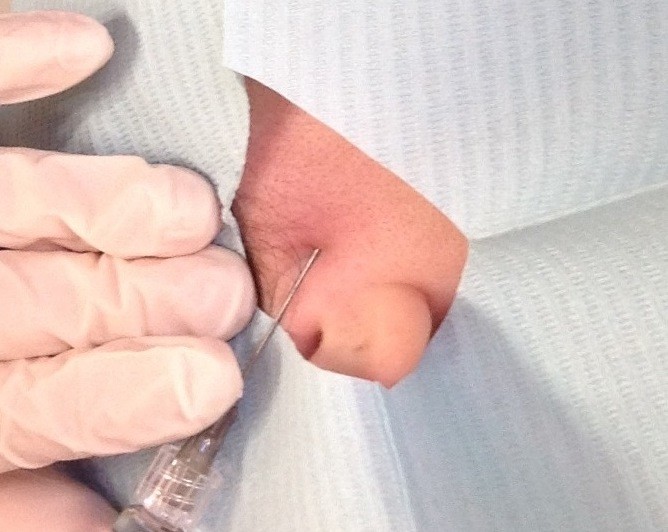TMJ injections are performed with corticosteroid and anesthetic to produce a two-fold effect: one reduce inflammation with the corticosteroid (triamcinolone acetonide) and two produce anesthesia or pain relief using lidocaine 2% without epinephrine. Corticosteriod is best used when swelling and pain are secondary to trauma, with acute OA flare ups, and DDNR cases.
Related Reading: TMJ Assessment: Jaw Range of Motion, Noise, and Tenderness
TMJ injections performed with a hyaluronic acid solution is done to temporarily reduce friction between the joint surfaces. Hyaluronic Acid is best used when patients are experiencing painful clicking, acute OA flare ups, and episodic locking of the TMJ.
Related Reading: Closed Lock Mobilization: TMJ Exercises & Stretches
Contraindications
- Acute injury to the jaw.
- Swollen, red or clearly inflamed TMJ.
Materials
- Triamcinolone 40mg/ml in multi-dose vial.
- Sodium hyaluronate in multi-does vial or syringe.
- 23 gauge needles (short).
- 27 gauge needles (long).
- Alcohol wipes.
- Sterile gauze.
Like what you’re learning? Download a brochure for our Orofacial Pain and Oral Medicine certificate or master’s degree program.
How to Perform a TMJ Injection
Prior to the procedure, introduce yourself to the patient, explain the purpose, obtain consent, and meet infectious control standards.
- Identify the tragus.
- Have the patient open their mouth wide and use a bite block to stabilize. A cork is suitable for this purpose.
- Identify the vacated joint space, just behind the lateral pole of the condyle and anterior to the tragus of the ear.
- Enter the skin about 3/8 of an inch, about 8mm in front of the middle of the tragus.
- Position the needle upward and slightly forward so that it slides beneath the zygoma, along the back of the condyle towards the posterior uppermost slope of the articular eminence.

- Aspirate to ensure you have no blood in the syringe before injecting.
- You should have little resistance to the injection and skin should not bubble up during injection.
- Use an ice pack over the area for at least 10 minutes.
- Assess the site of the injection for any profuse bleeding or inflammation.
- Prescribe an analgesic medication for 2-3 days.
- Ask the patient to avoid hard food of wide opening of the mouth for 5-7 days.
Post-Injection Protocol
- Prescribe ice packs if the joint aches after about 1-2 hours.
- Prescribe Acetaminophen if pain is moderate.
- If the injection is not within the joint space, the lidocaine may diffuse into the pre-auricular skin resulting in temporary anesthesia of the facial nerve or a Bell’s palsy lasting between 2 to 6 hours.
- Return to the clinic if any unusual skin reaction occurs.
Earn an Online Postgraduate Degree in Orofacial Pain and Oral Medicine
Are you interested in a variety of issues focused on orofacial pain, medicine and sleep disorders? Consider enrolling in the Herman Ostrow School of Dentistry of USC’s online, competency-based certificate or master’s program in Orofacial Pain and Oral Medicine.

